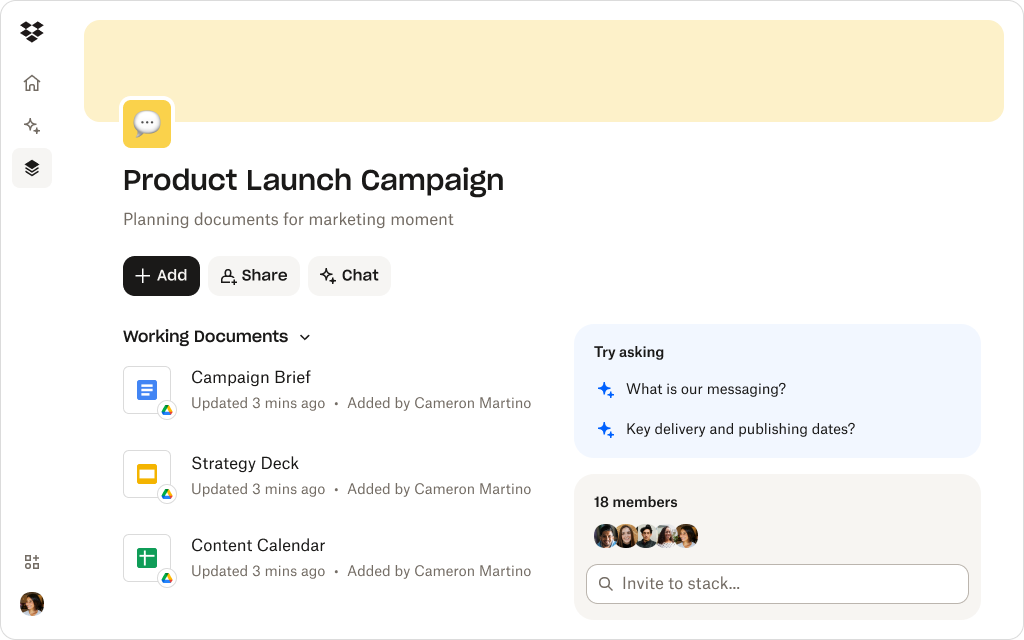
AI can speed up content creation—but can it deliver a one-pager that truly sells?
A marketing one-pager is a short, single-page summary that highlights the main message, value, and action steps of a product, campaign, or offer.
Every marketer knows the difference between a one-pager that informs and one that converts. The best one-pagers tell a story, frame a problem, and convince someone to take action in seconds. But when deadlines are tight and content needs multiply, teams are turning to AI to help get drafts out faster.
The question is, can AI land the right notes? Will it understand your audience’s pain points, your product’s unique value, and the emotional beats that make a message resonate?
The short answer is—only if it has context. Tools like Dropbox Dash achieve this by connecting your data with intuitive AI features, which means Dash helps create AI content that truly fuels conversion. Instead of starting from nothing, your team starts from insight—helping to craft one-pagers that sound genuine and actually close the deal.
Why marketers need one-pagers that work
In marketing and sales, a single page can make or break a deal—whether that’s for a direct purchase, an email sign-up, or even just brand recognition. It all builds to the same goal, but the best one-pagers take complex products and distill them into clear, persuasive stories that capture attention.
When done right, a one-pager does the following:
- It communicates value
- It builds trust
- It leaves no room for confusion
However, writing one-pagers is harder than it looks. Teams often struggle to balance speed with accuracy—especially when every detail has to stay on brand, meet compliance needs, and arrive customer-ready.
For example, a demand generation manager preparing collateral for a product launch might spend hours rewriting the same message for different audiences. Every change requires reviews, feedback, and approvals—all of which slow momentum.
That’s why the AI-powered features in tools like Dash are becoming so appealing—they promise to cut creation time in half without sacrificing quality. But do they really deliver?

Can AI really write effective marketing content?
We all know that AI writing tools can generate copy in seconds. Yet while the results can be impressive, they’re not always ready for client use. AI excels at speed and can provide a guide for structure—but it still struggles with certain things.
Here are a few ways AI writing tools can fall down:
- Missing nuance
- Incorrect brand tone
- Unclear message hierarchy
For marketers, the challenge is ensuring that your writing communicates the right story in the right way. However, without context, AI can produce content that’s generic, off-brand, or just plain inaccurate.
That’s where the human and AI balance becomes essential. People imagine AI taking over, but the reality is that it’s more like your best friend—for now. AI can assist you in doing the following:
- Outlining the framework and guiding the format for where your publishing
- Identifying key talking points to include in your one-pager
- Summarizing lengthy information to help you distill what matters more easily
Once AI has given you the building blocks, human marketers can then shape that output with the things that only humans can provide—creativity, empathy, and a final check on brand voice.
According to research by McKinsey, the productivity of marketing alone due to generative AI tools could increase total marketing spend by 5–15%. This dramatic figure underscores how AI can accelerate content production when paired with human review and oversight.
Overall, AI can help—but it still needs guidance.
What AI gets right—and wrong—about one-pagers
A one-pager is often a company’s first impression—a high-stakes blend of clarity, persuasion, and brand storytelling. It needs to make a case in just a few scrolls, turning complex value into instant understanding. AI can help lighten that load, but only when teams know where its strengths stop and human creativity begins.
AI is exceptionally good at:
- Summarizing complex information—it can condense long reports or product decks into digestible takeaways
- Structuring content logically—AI can instantly create sections like “Problem,” “Solution,” and “Benefits”
- Generating multiple variations—it can test different tones, audiences, or headlines to find what resonates
But it often struggles with:
- Understanding brand nuance—AI can mimic tone but not always meaningfully reflect brand personality
- Prioritizing what matters—without context, it may highlight minor details instead of key differentiators
- Fact-checking—AI can unintentionally mix data points or create outdated references
For example, an AI tool might produce a one-pager about a cloud security tool that sounds professional but omits the company’s most important proof point—its compliance certifications. Without that oversight, the piece feels polished but devoid of meaning.
AI is a great first draft partner—but not a final editor. It can accelerate writing, yet human context gives it direction. The best one-pagers happen when AI builds the framework and your team brings the soul that makes it stick.

Using Dash to create smarter, brand-aligned one-pagers
Dash helps marketing teams harness AI more intelligently.
Instead of starting from a blank page, Dash Chat draws from your company’s existing knowledge—all those contextual files, decks, campaign summaries, and brand guidelines—to generate content rooted in real meaning.
Teams can use Dash Chat to:
- Summarize previous campaigns or brand messaging documents into concise one-page overviews for customers or partners
- Draft copy in their approved tone of voice
- Experiment with prompts—or tweak examples from a prompt library to speed up deliverables
- Ask follow-up questions like “Can you make this section sound more customer-focused?” or “Add a bullet list of top benefits”
- Organize all one-pager drafts, assets, and feedback into a single Stack for easy review and version control
Because Dash connects to the tools teams already use—such as Dropbox cloud storage, Google Drive, Slack, and others—they can find and reuse approved content without toggling between apps. This ensures every AI-generated one-pager is accurate, consistent, and compliant with brand standards.
For example, a marketing operations lead can open Dash, pull in a recent campaign summary deck, and put the following prompt in Dash Chat: “Summarize this into a one-page customer handout for our new product launch.”
In seconds, Dash Chat produces a concise, structured draft with messaging aligned to the team’s existing materials. From there, it’s easy for teams to refine, review, and share.
Try prompts that make AI work harder for you
See how Dash’s prompt library helps teams create polished one-pagers and more.
Best practices for AI-assisted marketing content
AI can help marketers move faster—but speed only matters if it’s paired with substance.
The best content still depends on judgment, creativity, and clarity of purpose. To get real value from AI tools like Dash, marketers need to start with a coherent strategy.
To get the most value from AI tools like Dash, keep these principles in mind:
- Start with context—feed AI a source document, campaign brief, or messaging guide so it learns your priorities
- Edit for accuracy—verify claims, stats, and product details before finalizing copy
- Apply brand tone deliberately—use Dash’s prompt customization to guide phrasing, vocabulary, and voice
- Keep it human—the best one-pagers still reflect creativity, empathy, and personality—things machines can’t replicate
- Build a feedback loop—save successful prompts and iterations in Dash to refine future outputs
When marketers combine these best practices with tools like Dash, AI becomes a creative partner. It’s how teams move from simply producing more content to producing the right content—accurate, on-brand, and resonant.
Keep every one-pager consistent with Dropbox Dash
Great marketing collateral depends on clarity, consistency, and speed. Dash gives teams all three—helping them create, store, and share AI-assisted content that’s always accurate and aligned.
With a host of AI-powered features and a tool that understands your brand context, Dash ensures your next one-pager is just as fast as it is effective. See how Dash helps teams deliver one-pagers—contact sales or try a demo.
Frequently asked questions
Not yet. AI can handle structure and summaries, but humans still ensure nuance, tone, and persuasion. Think of AI as your speed boost, not your substitute—it can frame the story, but only you can make it resonate.
Dash grounds AI responses in your company’s approved content, so output stays accurate, brand-safe, and consistent. It’s the difference between guessing and knowing—Dash ensures your AI writes with context, not assumptions.
Yes. Teams use Dash to generate briefs, recaps, FAQs, reports, and other content from existing assets—all in one connected workspace. Once Dash understands your work, it becomes your creative co-pilot—ready to turn any document into something useful, fast.
Get started with Dash
.webp)

.svg)


